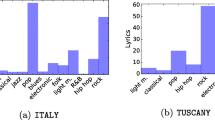Abstract
Nowadays there is a growing standardization of musical contents. Our finding comes out from a cross-service multi-level dataset analysis where we study how geography affects the music production. The investigation presented in this paper highlights the existence of a “fractal” musical structure that relates the technical characteristics of the music produced at regional, national and world level. Moreover, a similar structure emerges also when we analyze the musicians’ popularity and the polarity of their songs defined as the mood that they are able to convey. Furthermore, the clusters identified are markedly distinct one from another with respect to popularity and sentiment.
Access this chapter
Tax calculation will be finalised at checkout
Purchases are for personal use only
Similar content being viewed by others
References
Spotify. https://www.spotify.com/. Accessed 28 July 2017
Toscana100band contest. http://toscana100band.it/. Accessed 28 July 2017
Spotify Web API. https://developer.spotify.com/web-api/. Accessed 28 July 2017
Genius. https://genius.com/. Accessed 28 July 2017
SoundCloud API. https://developers.soundcloud.com/docs/api/guide. Accessed 28 July 2017
Google Form service. https://www.google.com/forms/about/. Accessed 28 July 2017
Spotify Audio Features Object. https://developer.spotify.com/web-api/get-several-audio-features/. Accessed 28 July 2017
AllMusic. http://www.allmusic.com/genres. Accessed 28 July 2017
Goslate. http://pythonhosted.org/goslate/. Accessed 28 July 2017
List of popular music genres, (n.d.). Wikipedia. http://en.wikipedia.org/wiki/Psychology. Accessed 28 July 2017
Clarke, F., Ekeland, I.: Nonlinear oscillations and boundary-value problems for Hamiltonian systems. Arch. Rat. Mech. Anal. 78, 315–333 (1982)
Clarke, F., Ekeland, I.: Solutions périodiques, du période donnée, des équations hamiltoniennes. Note CRAS Paris 287, 1013–1015 (1978)
Michalek, R., Tarantello, G.: Subharmonic solutions with prescribed minimal period for nonautonomous Hamiltonian systems. J. Differ. Equ. 72, 28–55 (1988)
Tarantello, G.: Subharmonic solutions for Hamiltonian systems via a \(Z\!\!Z_p\) pseudoindex theory. Annali di Matematica Pura (to appear)
Rabinowitz, P.: On subharmonic solutions of a Hamiltonian system. Commun. Pure Appl. Math. 33, 609–633 (1980)
Guidotti, R., Rossetti, G., Pedreschi, D.: Audio ergo sum. In: Milazzo, P., Varró, D., Wimmer, M. (eds.) STAF 2016. LNCS, vol. 9946, pp. 51–66. Springer, Cham (2016). https://doi.org/10.1007/978-3-319-50230-4_5
Rawlings, D., Ciancarelli, V.: Music preference and the five-factor model of the NEO personality inventory. Psychol. Music 25(2), 120–132 (1997)
Rentfrow, P.J., Gosling, S.D.: The do re mi’s of everyday life: the structure and personality correlates of music preferences. J. Pers. Soc. Psychol. 84(6), 1236 (2003)
Bu, J., Tan, S., Chen, C., Wang, C., Wu, H., Zhang, L., He, X.: Music recommendation by unified hypergraph: combining social media information and music content. In: Proceedings of the 18th ACM International Conference on Multimedia, pp. 391–400. ACM (2010)
Bischoff, K.: We love rock‘n’roll: analyzing and predicting friendship links in last. fm. In: Proceedings of the 4th Annual ACM Web Science Conference, pp. 47–56. ACM (2012)
Pennacchioli, D., Rossetti, G., Pappalardo, L., Pedreschi, D., Giannotti, F., Coscia, M.: The three dimensions of social prominence. In: Jatowt, A., Lim, E.-P., Ding, Y., Miura, A., Tezuka, T., Dias, G., Tanaka, K., Flanagin, A., Dai, B.T. (eds.) SocInfo 2013. LNCS, vol. 8238, pp. 319–332. Springer, Cham (2013). https://doi.org/10.1007/978-3-319-03260-3_28
Putzke, J., Fischbach, K., Schoder, D., Gloor, P.A.: Cross-cultural gender differences in the adoption and usage of social media platforms - an exploratory study of Last.FM. Comput. Netw. 75, 519–530 (2014). http://dx.doi.org/10.1016/j.comnet.2014.08.027
Park, M., Weber, I., Naaman, M., Vieweg, S.: Understanding musical diversity via online social media. In: Ninth International AAAI Conference on Web and Social Media (2015)
Zheleva, E., Guiver, J., Mendes Rodrigues, E., Milić-Frayling, N.: Statistical models of music-listening sessions in social media. In: Proceedings of the 19th International Conference on World wide web, pp. 1019–1028. ACM (2010)
Li, T., Ogihara, M., Peng, W., Shao, B., Zhu, S.: Music clustering with features from different information sources. IEEE Trans. Multimed. 11(3), 477–485 (2009)
Peng, W., Li, T., Ogihara, M.: Music clustering with constraints. In: ISMIR, pp. 27–32 (2007)
González-Pardo, A., Granados, A., Camacho, D., de Borja Rodríguez, F.: Influence of music representation on compression-based clustering. In: 2010 IEEE Congress on Evolutionary Computation (CEC), pp. 1–8. IEEE (2010)
Schmid, H.: Improvements in part-of-speech tagging with an application to German. In: Proceedings of the ACL SIGDAT-workshop. Citeseer (1995)
Schmid, H.: Part-of-speech tagging with neural networks. In: Proceedings of the 15th Conference on Computational Linguistics, vol. 1, pp. 172–176. Association for Computational Linguistics (1994)
Tan, P.-N., Steinbach, M., Kumar, V., et al.: Introduction to Data Mining, vol. 1. Pearson Addison Wesley, Boston (2006)
Pollacci, L., Guidotti, R., Rossetti, G.: Are we playing like Music-Stars? Placing emerging artists on the Italian music scene (2016)
Bradley, M.M., Lang, P.J.: Affective norms for English words (ANEW): instruction manual and affective ratings. Citeseer, Technical report (1999)
Lang, P.J.: Behavioral treatment and bio-behavioral assessment: computer applications (1980)
Dodds, P.S., Danforth, C.M.: Measuring the happiness of large-scale written expression: songs, blogs, and presidents. J. Happiness Stud. 11(4), 441–456 (2010)
Verhulst, P.F.: Recherches mathématiques sur la loi d’accroissement de la population. Nouveaux mémoires de l’académie royale des sciences et belles-lettres de Bruxelles 18, 14–54 (1845)
Acknowledgment
This work is partially supported by the European Project SoBigData: Social Mining & Big Data Ecosystem, http://www.sobigdata.eu. This work is partially supported by the European Communitys H2020 Program under the funding scheme “INFRAIA-1-2014-2015: Research Infrastructures” grant agreement, http://www.sobigdata.eu, GS501100001809, 654024 “SoBigData: Social Mining & Big Data Ecosystem”.
Author information
Authors and Affiliations
Corresponding author
Editor information
Editors and Affiliations
Rights and permissions
Copyright information
© 2018 ICST Institute for Computer Sciences, Social Informatics and Telecommunications Engineering
About this paper
Cite this paper
Pollacci, L., Guidotti, R., Rossetti, G., Giannotti, F., Pedreschi, D. (2018). The Fractal Dimension of Music: Geography, Popularity and Sentiment Analysis. In: Guidi, B., Ricci, L., Calafate, C., Gaggi, O., Marquez-Barja, J. (eds) Smart Objects and Technologies for Social Good. GOODTECHS 2017. Lecture Notes of the Institute for Computer Sciences, Social Informatics and Telecommunications Engineering, vol 233. Springer, Cham. https://doi.org/10.1007/978-3-319-76111-4_19
Download citation
DOI: https://doi.org/10.1007/978-3-319-76111-4_19
Published:
Publisher Name: Springer, Cham
Print ISBN: 978-3-319-76110-7
Online ISBN: 978-3-319-76111-4
eBook Packages: Computer ScienceComputer Science (R0)




